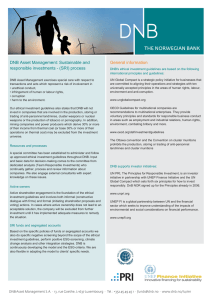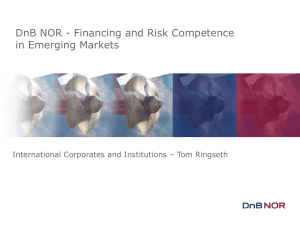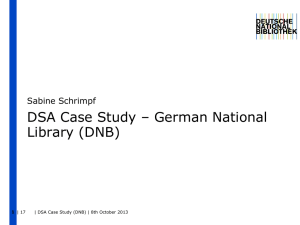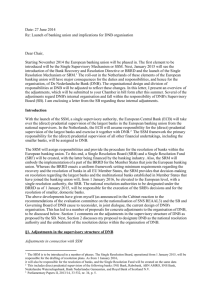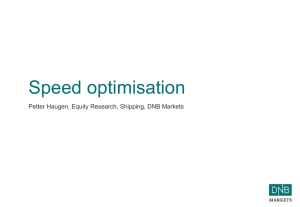pdf, 1.2 MB - eurosai 2014
advertisement
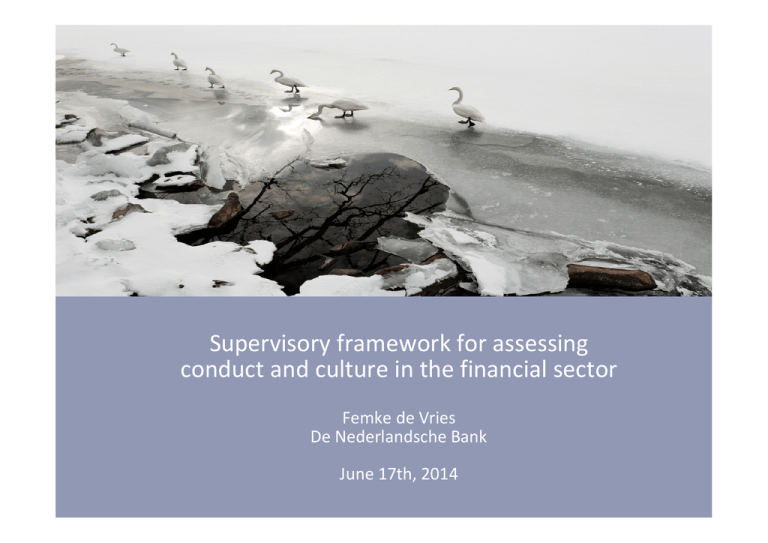
Supervisory framework for assessing conduct and culture in the financial sector Femke de Vries De Nederlandsche Bank June 17th, 2014 The Asch Experiment DNB 2 Pre-crisis supervision DNB 3 Post-crisis supervision DNB 4 Why supervision on culture & behaviour? • One of the causes of the crisis: not so much inadequate governance structures, but board and management behaviour within these structures • People determine a company’s performance • Risks relating to behaviour may already be apparent, while financially everything seems okay: • Behaviour has predictive value with respect to future financial performance • Early intervention may prevent future problems More rules alone will not prevent the next crisis DNB 5 Methodology DNB 6 Conduct and culture is one of the pieces of the puzzle Financial analysis (financial experts) Conduct and culture (psychologists) IT Risk (IT auditors) DNB Assessment of business models (strategic experts) Integrity risk (experts) 7 Culture Leiderschap: voorbeeldgedrag en bespreekbaarheid Besluitvorming: evenwichtig en consistent Communicatie: transparant DNB 8 Supervision on culture and behaviour • Het toezicht van DNB is gericht op het identificeren en voorkomen van risico’s Identifies thatvoortvloeien may emanateuit from behavior and culture: dierisks kunnen cultuur en gedrag. both risk based and “at random” Risk based in case of:is gericht op het beïnvloeden van instellingen om deze • Het toezicht van DNB Incidents (financial or non financial) risico’s teofverkleinen ofboard elimineren. Lot changes in the or sr management in short period of time Financial problems High risk appetite Non compliant behaviour • Naast traditioneel toezicht (solvabiliteit en liquiditeit) en niet in plaats van. Assesses these risks to cause institutions to eliminate these risks DNB Focus on the question whether leadership, group dynamics and decision making contributes to the (economical) performance of a firm We will intervene in case of riskfull behavior or lack of follow up 9 Methodology Decision Making + Board Effectiveness Desk research First intervention Interviews Survey & Selfassessment Discussion of findings Observations (meetings and log) Reports Start of second intervention = tracking follow up DNB 10 What is your opinion? • Culture cannot be translated into audit standards • Assessment of culture and behaviour should be part of any SAI risk analysis • SAIs can play an important role in stimulating neccessary culture changes in public sector organisations DNB 11 Results DNB 12 Case-Findings DNB 13 Case-Supervisory approach Report (on paper) Send to management and supervisory board => supervisory board and shareholder become involved, leading to several actions Bank itself replaces CEO and CFO and look for new CRO. DNB is involved in short list and selection Intensive follow up with respect to leadership, group dynamics and decisionmaking New board is receiving coaching on behavioural change. DNB 14 Key areas Culture change requires permanent attention of directors and auditors DNB 15 General impact of supervision on culture & behaviour cause Inter vention effect DNB Actual changes we see: − governance and staffing: changing board composition − changes in decision making processes: − more structured decision-making processes, − better preparation of decisions, − more involvement of key control functions, − evaluation of complex decision making, − organizing constructive challenge and debate − more facilitative leadership styles − better information-sharing between the management and supervisory board 16 Final comments • Every organization and every group may be affected by leadership problems or adverse group dynamics • DNB has found risky situations pertaining to culture & behavior and has caused the institutions to eliminate these risks • We also found good examples • However, there is still a lot more awareness needed and improvements to be made, which will take a lot of effort and time (change takes time!) • Permanent Board commitment and attention for culture & behavior within financial institutions remains required to prevent adverse effects from behavior and insufficiently considered decisions DNB 17 What is your experience? • Our SAI is committed to an ethical culture and behaviour within our own organisation • Our SAI has invested in facilitative leadership • Our SAI systematically organises internal and external challenge, dialogue and debate • Our SAIs decision making process is frequently evaluated DNB 18

